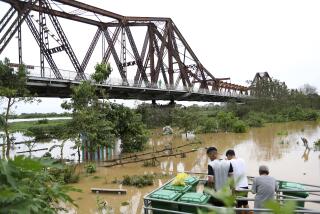Typhoon Hagibis leaves 33 dead as Japan continues rescues

- Share via
TOKYO — Helicopters, boats and thousands of troops were deployed across Japan on Sunday to rescue people stranded in flooded homes as the death toll from a ferocious typhoon climbed to as high as 33. One woman fell to her death as she was being placed inside a rescue helicopter.
Public broadcaster NHK said 14 rivers across the nation had flooded, some spilling out in more than one spot.
The casualty toll was compiled by Kyodo News service and was higher than one given by the government spokesman earlier Sunday, a day after Typhoon Hagibis made landfall south of Tokyo and battered central and northern Japan with torrents of rain and powerful gusts of wind.
“The major typhoon has caused immense damage far and wide in eastern Japan,” government spokesman Yoshihide Suga told reporters, adding that 27,000 military troops and other rescue workers were taking part in the operation.
News video showed a rescue helicopter hovering in a flooded area in Nagano prefecture where an embankment of the Chikuma River broke, and streams of water were continuing to spread over residential areas. The helicopter plucked those stranded on the second floor of a home submerged in muddy waters.
Aerial video showed tractors trying to control the flooding and several people on a rooftop, with one waving a white cloth to get the attention of a helicopter. Nearby was a child’s school bag. In another part, rows of Japan’s prized bullet trains, parked in a facility, were sitting in a pool of water.
A stretch of Fukushima, in the city of Date, was also flooded with only rooftops of residential homes visible in some areas, and rescuers paddled in boats to get people out. Parts of nearby Miyagi prefecture were also underwater.
The Tama River, which runs by Tokyo, overflowed its banks, flooding homes and other buildings in the area.
Authorities warned of a risk of mudslides. Among the reported deaths were people whose homes were buried in landslides. Other fatalities included people who got swept away by raging rivers.
Suga said recovery was on its way. Some 376,000 homes were without electricity, and 14,000 homes lacked running water, he said.
Boats as well as helicopters were sent to the flooded areas, while rescue crews dug through dirt elsewhere in search of people in homes buried by landslides.
Service on several train lines in the Tokyo area resumed in the early morning, although others were undergoing safety checks and were expected to restart later Sunday.
Ruling party politician Fumio Kishida said the government will do its best in rescue operations, including making sure that people in shelters were taken care of.
He acknowledged Japan’s power grids need to be strengthened so people in disaster areas can rely on timely information.
“So many risks remain, and it is a reality we must stay on guard,” Kishida said on an NHK-TV news talk show. “We must do our utmost. In these times, a disaster can hit any time.”
The Rugby World Cup match between Namibia and Canada, scheduled for Sunday in Kamaishi, northern Japan, was canceled as a precautionary measure, but organizers announced Japan will play Scotland as scheduled Sunday evening. Matches on Saturday had been canceled. Stores and amusement parks had also closed.
As the typhoon bore down Saturday with heavy rains and strong winds, the usually crowded train stations and streets of Tokyo were deserted because people had been advised to stay indoors. But life was quickly returning to normal under crisp clear skies Sunday.
Evacuation centers had been set up in coastal towns with tens of thousands seeking shelter. Kyodo News service said evacuation warnings had been issued to more than 6 million people.
The typhoon disrupted a three-day weekend in Japan that includes Sports Day on Monday. Qualifying for a Formula One auto race in Suzuka was pushed from Saturday to Sunday.
Authorities had repeatedly warned that Hagibis was on par with a typhoon that hit the Tokyo region in 1958. But the safety infrastructure that Japan’s modernization had brought was apparent. The typhoon six decades ago had left more than 1,200 people dead and 500,000 houses flooded.
More to Read
Sign up for Essential California
The most important California stories and recommendations in your inbox every morning.
You may occasionally receive promotional content from the Los Angeles Times.










